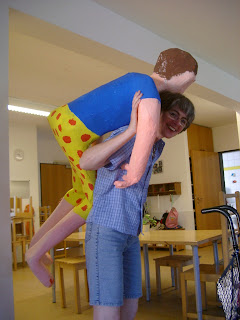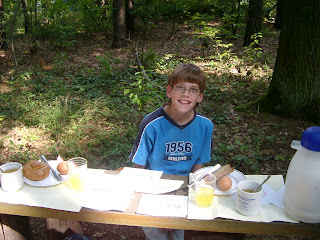
2007, London
Maybe the words "finding your feet" can describe what Mária Hári called "spontaneous orthofunction" just as well .
Finding one's feet is not only about learning to walk, it is also about finding one's way in life, learning to function in the society one lives in. A very small part of conductive upbringing is about learning to walk, one could almost say it is a by-product of discovering one’s way through life, developing one’s personality, finding one’s feet.
The big issue
When I am in Norwich I always buy The Big Issue, in Nürnberg it is the Straßenkreuzer. Both these magazines are sold by homeless people.
In the Big Issue that I bought on 28th May my attention was caught by an article called "Find your Feet” written by Scott Dolan, a “ homeless, ex-homeless or vulnerably housed” person.
I have reproduced the article in full as I am uncertain if just a quote or two would be enough to show why it moved me to write this posting.
Walking is such a joy to those who are fortunate enough to have the ability. From the early steps of a child, taking those first few steps, to observing the face of your mother and father as you begin to master those two big…( “what are these called, mum?” you ask, gesturing at the ground. “Feet” she replies). Yes, that’s it feet!
As we pass through our childhood, our teenage years and early adulthood, we find ourselves habitually forced to move around faster and faster. Take the time to sit on a bench at a train station or a town centre and you will witness this clumsy act of speed-walking - a swarm of parasitic life rushing with the utmost urgency to conform. Is this really the same thing that I learnt to do, such a long time ago?
No, it’s not! From the early age of three or four years old, we walk naturally. Then we learn that we can’t – we just don’t have time to walk this way. I remember almost being dragged as a child when leaving pre-school, holding mum’s hand on the way home. Just walking, it seems is rare to witness these days.
As a young boy, I would dream of walking vast distances on continents and lands I had no comprehension of. I would be carrying my backpack, my walking staff and a sturdy sheath knife for protection should I be attacked by wolves or a dragon.
Walking is such a therapeutic thing. We should accept the fact that we have truly forgotten how to walk. If we took the time to slow down and observe the true “interconnectivity” of our surroundings, our respiratory rate would slow down; we would be calmer and more in control of ourselves.
If you plan an evening walk, you depart from a certain point and you may arrive at a certain point, but the totally random encounters on the way would be different every time.
The existential moment of the breath, the movement of the body, and the connection of the foot with the earth are truly sacred in nature. My struggle for today is to transport my body through my inventory of daily anxieties, and to arrive at a final destination where I will lay my body down in a safe place to sleep.
Every day I wake up, and every day that I live I am still learning how to walk. Even at the prime age of 28. It’s free to walk and it’s free to learn.”
Saving time
The first image that came to my mind as I read this article was something I would love to say never happens, but unfortunately it does: a disabled child walking out of a Conductive Education session as proud as punch to be walking independently, walking slowly but surely under his own steam with a walking frame, with sticks or absolutely unaided, only for a parent to grab him by the hand or to carry him the last few metres to the car. The reason is... not enough time.
That therapeutic feeling is gone, the lightening of the soul is gone, the sense of success maybe not altogether gone, but different, changed.
I have witnessed this scene many times all for the purpose of saving time, saving five minutes.
The joy of walking
The writer began by stating “Walking is such a joy to those who are fortunate enough to have the ability”.
How many of us ever consider this, that the gift of walking brings us joy?
How many conductors or other professionals working with physically disabled clients stop to give a thought to what it feels like to be able to walk?
Do we consciously realise that something which is part of the daily routine of teaching can in fact be so joyous?
You only need to see the look on a child’s face when he takes his first tentative step to recognise the pleasure and to see the joy, or to watch a parents’ reactions as they observe this for the first time. It makes no difference if it is a one-year-old, a five-year-old or a fifty-year-old, the feeling is the same, it is pure joy to be vertical and moving forwards.
Walking games
Until recently I didn’t walk long distances very often because I was usually on my bike, but since the move into the city I walk more.
As I have longish legs I can take big strides, which gives me the feeling that I am strolling when in fact I am gliding along quite quickly. I feel relaxed as I lift my feet so that I don’t trip over cracks in the pavements and, as I walk, I am consciously aware of the length of each step and how I place my feet. I have time to look around.
It is different to being on a bike.
While cycling I am only really aware of my movements if I am travelling slowly uphill. or at speed downhill when greater concentration is afforded and more effort is required. At other times, when riding on the flat, I dream a lot!
While walking I try to concentrate on every step. I don’t remember if I always did this but I think it probably started while walking to and from school when I had several games that I would play. Over the years these games changed from active jumping games to more sedentary mathematical games. I expect most of us have tried to avoid walking on cracks in the pavement or experimenting using “scout's pace”. Maybe also counted the paces between trees on a regular route, trying to match the number each journey, alternated fast and slow walking or the size of the paces, or estimated how many strides are needed to a certain point.
As I played so many walking games over the years I suppose I have always been interested in the way in which I walk. On becoming a conductor this interest increased. Now I concentrate more on the posture and style that helps prevent aging joints!
These days there are many reports in health magazines telling us of the importance of a good posture while sitting at a desk working, but they have little to say about walking and never tell us that we can do a lot to improve our health while walking, if only by slowing down and relaxing, and recognise its therapeutic value,as mentioned in The Big Issue.
The gift of time
The Big Issue also says: “I remember almost being dragged as a child when leaving pre-school”. I expect many of us have either experienced this or witnessed it happening.
As conductors we witness it too, it is our responsibility to slow the world down so our clients can achieve success.
We teach a child how to break down problems task by task, we show them how to slowly build one task slowly on another to reach solutions. The children learns that when first learning to take steps they need to build in the task of standing still for a moment, to leave themselves time to balance or transfer weight. They learn how to hold their head or arms, they develop a posture that is the best for them at the moment to enable walking. They learn to take time and they may learn to walk independently.
Then what happens ?
Most probably they will soon have to learn how to hurry, as the world has no time to wait for them. At school there is no time between lessons, so the child will be “led “ by the hand or will use a wheelchair, in the playground it is too ”dangerous”, so again a wheelchair or walker will be needed.
The Big Issue writer says that we have truly forgotten how to walk and I agree. Many people have forgotten and we could all benefit from taking time out, sitting on that bench at the train station, to observe what is happening to our bodies in the rush to save time.
As we walk around our home, walk to the shops, walk the dog or take the children to school, we can take notice of how we are moving, concentrate in the same way that one has to when climbing a mountain or riding a bike up a steep hill. We can become aware of all the intricate movements that we make to stay upright and move forwards. We can take a deep breath, change down a gear and experience it as if doing it for the first time. We can experience the joy that we get from walking and maybe we can learn to be patient and give a present of time to those who have no choice but to walk slowly.
We can also look at children in the conductive setting, how they learn step by step to solve problems, how they know that they need a certain amount of time to eat their meal alone, need peace and quiet to stand and clean their teeth, and how precisely they need to place their feet to be able to walk. We must give these children time and maybe in time they will find the solution to the problem of how to keep up with the rest of the “rushing” world.
As usual Dr Mária Hári had something to say about this:
“The timetable must ensure the time necessary to do something well. It is only in the framework of such a programme that we can attain our goal”
It is important that outside the programme there should also the necessary amount of time available for achieving success, for doing things well, for feeling the joy in our souls.
Notes
http://www.strassenkreuzer.info/
The Big Issue, 26 May - 1 June 2008
Street Lights, The voice of the streets, Find Your Feet by Scott Dolan
The Street Light pages of The Big Issue are "exclusively by homeless, ex-homeless and vulnerably housed people. It is a space for them to air their views and opinions, and to display their work."
http://www.bigissue.com/
Scout's Pace a combination of walking and running that we practised in the Girl Guides in order to travel faster from A to B without becoming exhausted.
Mária Hári on Conductive Pedagogy, edited by Gill Maguire and Andrew Sutton
ISBN 1-897588-24-0


























